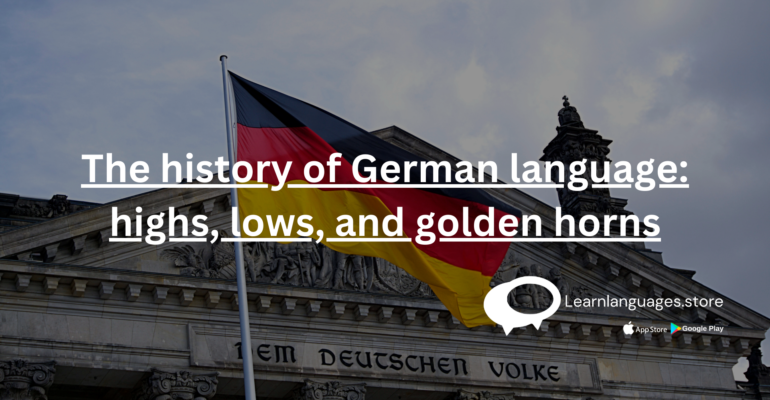The history of German language: highs, lows, and golden horns
The history of German language: highs, lows, and golden horns
Estimated reading time: 11 minutes
I’m very sure you’re interested in German if you’re enjoying Oktoberfest this year while holding a bratwurst in one hand and a beer in the other. Perhaps you have even been reviewing your German language skills in order to get ready for the festivities!
However, Oktoberfest is only a small part of the culture of the German-speaking areas. There is still so much to learn and investigate, particularly in regards to the language. You’ve been developing some fantastic Sprachgefühl, or feelings toward language, if you’ve been learning German and have observed some parallels with your own tongue. There’s also a ton of information on German history to give you that Sprachgefühl!
Peaks and valleys
Despite the fact that we speak “German” today, this language has evolved over centuries through a variety of dialects. Before we get started, the most important distinction to make is between High German and Low German.
Plattdüütsch, or Low German, is the language that is still spoken in some regions of the Netherlands and Northern Germany as well as in the places where those people have moved overseas. English is most closely linked to this variant of German! Even while non-Germanic terms make up between two third and three quarters of the English language, there are still many Germanic words that we use on a daily basis, such as “day.”
Hochdeutsch, or High German, is the language that emerged in the territories south of the Low German ones as well as in the places where they settled globally.
Modern Standard High German, often known as Standarddeutsch, is the variation of German that you are studying on Duolingo. German writers experimented with several versions of the language over time, until finally it developed into Modern Standard High German.
A significant distinction between Low German and High German is a result of changes made to the consonants throughout time. For instance, “p” remained the same in Low German but eventually changed to “f” in High German. These distinctions are still evident today, with High German having the “f” and Low German and Modern English having the “p”:
| ENGLISH | LOW GERMAN | HIGH GERMAN |
|---|---|---|
| ship | Schepp | Schiff |
| sleep | schloppen | schlafen |
However, there have been additional changes that have made German dialects quite distinct from one another! Throughout all of the significant periods in German history, there have been a number of extremely fascinating linguistic and social changes:
German High Ages
German Intermediate
New High German in its early stages
Modern Standard High German, often known as New High German
Let’s take a closer look at all the various varieties of German spoken throughout history!
Runes and Red Riding Hood
The German you are studying comes from Proto-Germanic, which is the progenitor of all modern Germanic languages, such as Swedish, English, and German. The original Germanic language divided into several dialects throughout time, and these dialects eventually formed their own language families! Germanic languages nowadays can be divided into two categories: “West Germanic” languages and Scandinavian languages like Danish and Norwegian. German is a member of this West Germanic language family!
The languages of Europe and certain areas of Asia were very different from this early Germanic language. Comparing the sounds of Proto-Germanic with those of languages that are more distantly related might help us understand how distinct it was from its neighbors:
First Germanic Sound Shift: Proto-Germanic underwent this transformation a long time ago, although Latin and other European languages did not. Thus, in Latin, words beginning with “p” correlate to “f” in Germanic languages. German historians also refer to this as Grimm’s Law—yes, THAT Jacob Grimm, the one who wrote Cinderella and Snow White.
| LATIN | GERMAN | SWEDISH | ENGLISH |
|---|---|---|---|
| pes | Fuß | fot | foot |
| piscis | Fisch | fisk | fish |
Second Germanic Sound Shift: As we saw above, High German began pronouncing a “f” where Low German has a “p.” This is another significant change in sounds. This subsequent development further distinguished the German variations from one another.
Changes in sound were not the only thing occurring during this early stage. The Germanic tribes began migrating and settling outside of their native regions around the fourth century. They employed a script called the Elder Futhark, so named because the word “futhark” is spelled out in the first six runes of the alphabet.Typically, these texts are discovered engraved on historical items; the most well-known example is located on the smaller of Gallehus’ Golden Horns. Fortunately, some individuals had the good sense to build copies and draw the horns after they were taken in the 19th century and probably melted down, allowing us to still read the inscription: ek hlewagastiz holtijaz horna tawido. That’s very awesome, isn’t it? Words played on such a lovely instrument and transmitted to us in the present day. What do they intend to convey to us? Naturally, without any build-up, our Germanic forefathers inform us that Hlewagast, the son of Holt, was the one who created the horn!
Hogwarts and Hildebrand in Old High German
historical High German is the term used to describe the dialect used between 750 and 1050 in historical writings, especially those penned by Christian monks. The vocabulary, syntax, and spelling still varied widely, and there was significant interaction between Old High German and the highly esteemed Latin. This is the time when terms like Schule (school) from the Latin schola and schreiben (to write) from the Latin scribere originated.
The epic poem Hildebrandslied, which dates to the ninth century and describes Hildebrand and his son Hadubrand’s encounter on the battlefield, is among the most well-known pieces of Old High German literature. It’s not quite like the last battle between Darth Vader and Luke Skywalker because—spoiler alert—most people believe the son, Hadubrand, is murdered by his father.
The Merseburg Incantations, which describe the pre-Christian beliefs of the Germanic people, are another well-known collection of Old High German literature. An account of the Germanic gods contains the invocation itself. As they are enjoying themselves greatly in the woods, one of their horses’ foot becomes dislocated. Say the following charm to heal the horse:
May they be bonded together, ben zi bena, bluot zi bluoda, lid zi geliden,
sose gelimida sin bone to bone, blood to blood, joint to joints
Though it might not seem as natural as uttering brackium emendo at Hogwarts, the early Germanic gods probably found it just as effective!
German Middle High: courtly love
Middle High German appeared by around 1050–1350, which corresponds roughly with the High Middle Ages. Because of the constant rise in literacy, writers began to come from a variety of social backgrounds, and their language reflected these distinctions. Additionally, at this time, German migrated geographically into what is now Hungary, Poland, the Czech Republic, and other parts of the former Holy Roman Empire.
Perhaps the most famous Middle High German writer was Walther von der Vogelweide—a medieval heartthrob who composed and performed songs about love and politics. His love poem Under der linden (Under the Linden Tree) is about a secret rendezvous between two lovers in the woods. It begins innocently enough but increases steadily in sultriness, all while a lone nightingale sings in the distance:
Under der linden an der heide, dâ unser zweier bette was, dâ muget ir vinden schône beide gebrochen bluomen unde gras
Under the linden tree on the heath, you can find our communal bed made of crushed flowers and pressed-down grass
German learners might be able to make out some familiar words:
| MIDDLE HIGH GERMAN | MODERN GERMAN | MODERN ENGLISH |
|---|---|---|
| heide | die Heide | heath |
| bette | das Bett | bed |
| vinden | finden | find |
| gebrochen | gebrochen | broken |
| bluomen unde gras | Blumen und Gras | flowers and grass |
Indeed, it is around this time that the prefix ge-begins to be regularly used for participles such as gebrochen (broken)!
In Old High German, nouns usually altered according on where they fell in a sentence. However, in Middle High German, such endings started to appear more frequently on adjectives and articles like “a” and “the,” rather than on nouns. Yes, adjective endings are the scourge of modern German learners, including Mark Twain, who famously remarked that he would prefer turn down two beers than one German adjective!
The non-father of the German language and early New High German
We consider the period around 1450 to be the Early New High German era, during which several dialects in the area competed with one another politically and economically. Around this same period, a misconception emerged over who was in charge of standardizing German: Protestant reformer Martin Luther is referred to as the “father of the German language.” He wasn’t, though.
There remained a great deal of socially and culturally driven variance even after early attempts to create a standard language. Lutherdeutsch, also known as Meißnisch, was the dialect of German that Luther used to translate the Bible, and Protestant German-speaking regions naturally adopted it. However, Catholic regions, for instance, continued to speak gemeines Deutsch, or East Upper German. Luther’s translation did introduce several colloquial terms like “Ebenbild” (spitting picture) to German, which are still widely used today. Luther’s German, however, did not always survive the years. For instance, his variation used flugs for “soon,” while modern German uses the term bald instead. Nevertheless, current learners of German may understand Luther’s early 16th-century translation of the Bible with ease.
| LUTHER’S BIBLE TRANSLATION | MODERN STANDARD GERMAN | MODERN ENGLISH |
|---|---|---|
| Am Anfang schuf Gott Himmel und Erde. | Im Anfang schuf Gott Himmel und Erde; | In the beginning God created the heavens and the earth. |
| Und die Erde war wüst und leer, und es war finster auf der Tiefe; und der Geist Gottes schwebete auf dem Wasser. | die Erde aber war wüst und wirr, Finsternis lag über der Urflut und Gottes Geist schwebte über dem Wasser. | Now the earth was formless and empty, darkness was over the surface of the deep, and the Spirit of God was hovering over the waters. |
| Und Gott sprach: Es werde Licht! Und es ward Licht. | Gott sprach: Es werde Licht. Und es wurde Licht. | And God said, “Let there be light,” and there was light. |
Thus, despite the fact that Luther did not originate or establish the German language, his Bible had a significant influence on language, society, politics, and religion. A growing percentage of people in society were gaining literacy, partly due to German printer Johannes Gutenberg’s invention of the printing press. Attempts to standardize German were fuelled by the increased availability of publications, as well as by urbanization and population development.
During this period, there was also a significant rise in German-French communication, leading to the creation of German terms such as Adresse (address), Moment (moment), and Autor (author). (Which language also borrowed those terms into English?) These terms have real equivalents rooted in German, but French, like English, has a way of creeping into languages.
New High German: The one thing that never changes is
After the German Empire came together in 1871, there was a growing desire for German people to speak the same language. When the Duden grammar and dictionary—which is still used today—was published in the late 19th century, language clubs and other factors contributed to the push for New High German standardization.
German is still evolving even though there is now a standard language that is taught and mastered! Standardization is neither the end of the road or the full tale in a long history of German invention and change, even if it may be significant for social, cultural, political, and language learning reasons. A few instances of linguistic change in action are as follows:
The old subjunctive is gone, and the new one is in. würde stehen and würde werfen are replacing the earlier subjunctive verb forms in German, such as stünde and würfe. They may appear natural in writing, but most German speakers find them unnatural and outdated.
Increased modals. The word brauchen, which means “to need,” is likewise becoming increasingly common and is becoming one of the modal verbs; however, perhaps that is something I don’t need to tell you!
In a technical sense. I bims ‘ich bin / ich bin’s’, a variant of “I am/it’s me,” was chosen as the 2017 Langenscheidt Youth Word of the Year by Vong-Sprache, a social media and online writing style.
An increasing amount of English. Language purists are more focused on the usage of English terms in German. When the German word Wellness was allowed as a verb (wellnessen) in the Duden language the same year, several German speakers found it unbelievable that their chancellor had used the term “shitstorm.”
Both in German-speaking nations and the German-speaking diaspora, multilingualism has given rise to several contemporary and traditional German variants. You may hear German grammar experts bemoan the demise of the standard, just as it is for English, French, and other languages, but in reality, these new varieties of German (such as Kiezdeutsch, or “neighborhood German”) innovate in precisely the same ways that German has always been moving and changing. Many German variations that are spoken today by so many multilingual people—very proficient language users!—are the outcome of striking a balance between two or more languages and all the social and cultural facets that come with belonging to many cultures.
Language changes to match the lives and needs of the people speaking it. If it didn’t change, we’d still be tawaido-ing our horna, right?
Since German has several centers across Europe and abroad, several dialects of the language inevitably arise. In Germany, Austria, Liechtenstein, Switzerland, Luxembourg, Belgium, and South Tyrol (Italy), German is either the official or co-official language. In many regions of Eastern Europe, it is also a minority language acknowledged by law. And just as there was in Luther’s day, there is still a great deal of variety in all those regions where German is legitimized.
German speakers left Europe and settled all over the world, taking their languages with them. Along with the dialectal basis developed in the motherland, each group also carries parts of the language they currently speak in addition to their heritage German. German heritage dialects are extensively spoken everywhere in the world, from Pennsylvania to Ontario, and from Brazil to Namibia. Every one of them has a unique history of linguistic evolution as German immigrant and colonial dialects; some even predate contemporary standardization efforts. However, Germans living abroad need their own blog article!
Learn Languages Store
Vashi,
Email: services@learnlanguages.store










